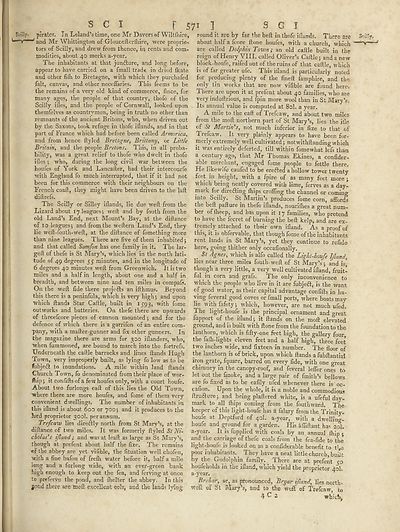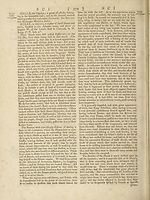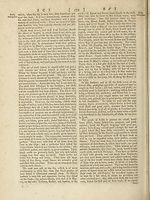Encyclopaedia Britannica, or, a Dictionary of arts, sciences, and miscellaneous literature : enlarged and improved. Illustrated with nearly six hundred engravings > Volume 18, RHI-SCR
(607) Page 571
Download files
Complete book:
Individual page:
Thumbnail gallery: Grid view | List view

SCI r 571 1 SGI
Scilly* pirates. In Leland’s time, one Mr Davers of Wiltthire,
and Mr Whittington of Gloucefterfhire, were proprie¬
tors of Scilly, and drew from thence, in rents and com¬
modities, about 40 merks a-year.
The inhabitants at that juncture, and long before,
appear to have carried on a fmall trade in dried Ikate
and other fiih to Bretagne, with which they purchafed
fait, canvas, and other neceffaries. This feems to be
the remains of a very old kind of commerce, fince, for
many ages, the people of that country, thofe of the
Scilly ifles, and the people of Cornwall, looked upon
themfelves as countrymen, being in truth no other than
remnants of the ancient Britons, who, when driven out
by the Saxons, took refuge in thofe illands, and in that
part of France which had before been called Armorica,
and from hence ftyled Bretagne, Brittany, or Little
Britain, and the people Bretons, This, in all proba¬
bility, w'as a great relief to thofe who dwelt in thofe
ifles ; who, during the long civil war between the
houfes of York and Lancafter, had their intercourfe
with England fo much interrupted, that if it had not
been for this commerce with their neighbours on the
French coaft, they might have been driven to the laft
diftrefs.
The Scilly or Silley iilands, lie due weft from the
Lizard about 17 leagues; weft and by fouth from the
old Land’s End, next Mount’s Bay, at the diftance
of 10 leagues; and from the weftern Land’s End, they
lie weft-fouth-weft, at the diftance of fomething more
than nine leagues. There are five of them inhabited;
and that called Samfon has one family in it. The lar¬
ge!! of thefe is St Mary’s, which lies in the north lati¬
tude of 49 degrees 55 minutes, and in the longitude of
6 degrees 40 minutes weft from Greenwich. It is two
miles and a half in length, about one and a half in
breadth, and between nine and ten miles in compafs.
On the weft fide there proje£ts an ifthmus. Beyond
this there is a peninfula, which is very high; and upon
which Hands Star Caftle, built in 1593, with fome
outworks and batteries. On thefe there are upwards
of threefcore pieces of cannon mounted ; and for the
defence of which there is a garrifon of an entire com¬
pany, with a mafter-gunner and fix other gunners. In
the magazine there are arms for 300 iflanders, who,
when fummoned, are bound to march into the fortrefs.
Underneath the caftle barracks and lines {lands Hugh
Town, very improperly built, as lying fo low as to be
fubje£! to inundations. A mile within land Hands
Church Town, fo denominated from their place of wor-
fhip; it confiftsof a few houfes only, with a court houfe.
About two furlongs eaft of this lies the Old Town,
where there are more houfes, and fome of them very
convenient dwellings. The number of inhabitants in
this ifiand is about 600 or 700; and it produces to the
lord proprietor 3G0I. per annum.
Trefcaw lies dire£Hy north from St Mary’s, at the
diftance of two miles. It was formerly ftyled St Ni¬
cholas's ijland; and was at leaf! as large as St Mary’s,
though at prefent about half the fize. The remains
of the abbey are yet vifible, the fituation well chofen,
with a fine bafon of frefh water before it, half a mile
ieng and a furlong wide, with an ever-green bank
high enough to keep out the fea, and ferving at once
to prefer ye the pond, and ftielter the abbey. In this
jotid there are mo ft excellent eels, and the lands lying
round it are by far the beft in thofe ifiands. There are Sally,
about half a fcore ftone houfes, with a church, which —“v—~
are called Dolphin Town; an old caftle built in the
reign of Henry VIII. called Oliver’s Caftle; and a new
block-houfe, raifed out of the ruins of that caftle, which
is of far greater ufe. This ifiand is particularly noted
for producing plenty of the fineft famphire, and the
only tin works that are now vifible are found here.
There are upon it at prefent about 40 families, who are
very induftrious, and fpin more wool than in St Mary V.
Its annual value is computed at 80I. a year.
A mile to the eaft of Trefcaw, and about two miles
from the moft northern part of St Mary’s, lies the iile
of St Martin's, not much inferior in fize to that of
Irefcaw. It very plainly appears to have been for¬
merly extremely well cultivated; notwithftanding which
it was entirely deferted, till within fomewhat lefs than
a century ago, that Mr Thomas Ekines, a confider-
able merchant, engaged fome people to fettle there.
He likewife caufed to be ereifted a hollow tower twenty
feet in height, with a fpire of as many feet more ;
which being neatly covered with lime, ferves as a day-
mat k for diredling (hips crofting the channel or coming
into Scilly. St Martin’s produces fome corn, affords
the beft pafture in thefe ifiands, nourifhes a great num¬
ber of fheep, and has upon it 17 families, who pretend
to have the fecret of burning the beft kelp, and are ex¬
tremely attached to their own ifiand. As a proof of
this, it is obfervable, that though fome of the inhabitants
rent lands in St Mary’s, yet they continue to refide
here, going thither only occafionally.
. St Agnes, which is alfo called the Light-houfe Ijland,
lies near three miles fouth-weft of St Mary’s; and is’
though a very little, a very well cultivated ifiand, fruit¬
ful in corn and grafs. The only inconvenience to
which the people who live in it are fubjeft, is the want
of good water, as their capital advantage confifts in ha¬
ving feveral good coves or fmall ports, where boats may-
lie with fafety; which, however, are not much ufed.
The light-houfe is the principal ornament and great
fupport of the ifiand; it Hands on the moft elevated
ground, and is built with ftone from the foundation to the
lanthorn, which is fifty-one feet high, the gallery four
the fafh-lights eleven feet and a half high, three feet
two inches wide, and fixteen in number. The floor of
the lanthorn is of brick, upon which ftands a fubftantial
iron grate, fquare, barred on every fide, with one great
chimney in the canopy-roof, and feveral leffer ones to
let out the fraoke, and a large pair of fmith’s bellows
are fo fixed as to be eafily ufed whenever there is oc-
cafion. Upon the. whole, it is a noble and commodious
ftru&ure; and being plaftered white, is a ufeful day-
mark to all fhips coming from the fouthward. The
keeper of this light-houfe has a falary from the Trinity-
houfe at Deptford of 40I. a-year, with a dwelling-
houfe and ground for a garden. His affiftant has 20I.
a-year. It is fupplied with coals by an annual fhip ;
and the carriage of thefe coals from the fea-fide to the
light-houfe is looked on as a confiderable benefit to t^e
poor inhabitants.. They have a neat little church, built
by the Godolphin family. There are at prefent 50
houfeholds in the ifiand, which yield the proprietor 40I.
a-year.
Brehar, er, as pronounced, Bryar ijland, lies north-
weft of St Mary’s, and to the weft of Trefcaw, to
4 C 2 which.
Scilly* pirates. In Leland’s time, one Mr Davers of Wiltthire,
and Mr Whittington of Gloucefterfhire, were proprie¬
tors of Scilly, and drew from thence, in rents and com¬
modities, about 40 merks a-year.
The inhabitants at that juncture, and long before,
appear to have carried on a fmall trade in dried Ikate
and other fiih to Bretagne, with which they purchafed
fait, canvas, and other neceffaries. This feems to be
the remains of a very old kind of commerce, fince, for
many ages, the people of that country, thofe of the
Scilly ifles, and the people of Cornwall, looked upon
themfelves as countrymen, being in truth no other than
remnants of the ancient Britons, who, when driven out
by the Saxons, took refuge in thofe illands, and in that
part of France which had before been called Armorica,
and from hence ftyled Bretagne, Brittany, or Little
Britain, and the people Bretons, This, in all proba¬
bility, w'as a great relief to thofe who dwelt in thofe
ifles ; who, during the long civil war between the
houfes of York and Lancafter, had their intercourfe
with England fo much interrupted, that if it had not
been for this commerce with their neighbours on the
French coaft, they might have been driven to the laft
diftrefs.
The Scilly or Silley iilands, lie due weft from the
Lizard about 17 leagues; weft and by fouth from the
old Land’s End, next Mount’s Bay, at the diftance
of 10 leagues; and from the weftern Land’s End, they
lie weft-fouth-weft, at the diftance of fomething more
than nine leagues. There are five of them inhabited;
and that called Samfon has one family in it. The lar¬
ge!! of thefe is St Mary’s, which lies in the north lati¬
tude of 49 degrees 55 minutes, and in the longitude of
6 degrees 40 minutes weft from Greenwich. It is two
miles and a half in length, about one and a half in
breadth, and between nine and ten miles in compafs.
On the weft fide there proje£ts an ifthmus. Beyond
this there is a peninfula, which is very high; and upon
which Hands Star Caftle, built in 1593, with fome
outworks and batteries. On thefe there are upwards
of threefcore pieces of cannon mounted ; and for the
defence of which there is a garrifon of an entire com¬
pany, with a mafter-gunner and fix other gunners. In
the magazine there are arms for 300 iflanders, who,
when fummoned, are bound to march into the fortrefs.
Underneath the caftle barracks and lines {lands Hugh
Town, very improperly built, as lying fo low as to be
fubje£! to inundations. A mile within land Hands
Church Town, fo denominated from their place of wor-
fhip; it confiftsof a few houfes only, with a court houfe.
About two furlongs eaft of this lies the Old Town,
where there are more houfes, and fome of them very
convenient dwellings. The number of inhabitants in
this ifiand is about 600 or 700; and it produces to the
lord proprietor 3G0I. per annum.
Trefcaw lies dire£Hy north from St Mary’s, at the
diftance of two miles. It was formerly ftyled St Ni¬
cholas's ijland; and was at leaf! as large as St Mary’s,
though at prefent about half the fize. The remains
of the abbey are yet vifible, the fituation well chofen,
with a fine bafon of frefh water before it, half a mile
ieng and a furlong wide, with an ever-green bank
high enough to keep out the fea, and ferving at once
to prefer ye the pond, and ftielter the abbey. In this
jotid there are mo ft excellent eels, and the lands lying
round it are by far the beft in thofe ifiands. There are Sally,
about half a fcore ftone houfes, with a church, which —“v—~
are called Dolphin Town; an old caftle built in the
reign of Henry VIII. called Oliver’s Caftle; and a new
block-houfe, raifed out of the ruins of that caftle, which
is of far greater ufe. This ifiand is particularly noted
for producing plenty of the fineft famphire, and the
only tin works that are now vifible are found here.
There are upon it at prefent about 40 families, who are
very induftrious, and fpin more wool than in St Mary V.
Its annual value is computed at 80I. a year.
A mile to the eaft of Trefcaw, and about two miles
from the moft northern part of St Mary’s, lies the iile
of St Martin's, not much inferior in fize to that of
Irefcaw. It very plainly appears to have been for¬
merly extremely well cultivated; notwithftanding which
it was entirely deferted, till within fomewhat lefs than
a century ago, that Mr Thomas Ekines, a confider-
able merchant, engaged fome people to fettle there.
He likewife caufed to be ereifted a hollow tower twenty
feet in height, with a fpire of as many feet more ;
which being neatly covered with lime, ferves as a day-
mat k for diredling (hips crofting the channel or coming
into Scilly. St Martin’s produces fome corn, affords
the beft pafture in thefe ifiands, nourifhes a great num¬
ber of fheep, and has upon it 17 families, who pretend
to have the fecret of burning the beft kelp, and are ex¬
tremely attached to their own ifiand. As a proof of
this, it is obfervable, that though fome of the inhabitants
rent lands in St Mary’s, yet they continue to refide
here, going thither only occafionally.
. St Agnes, which is alfo called the Light-houfe Ijland,
lies near three miles fouth-weft of St Mary’s; and is’
though a very little, a very well cultivated ifiand, fruit¬
ful in corn and grafs. The only inconvenience to
which the people who live in it are fubjeft, is the want
of good water, as their capital advantage confifts in ha¬
ving feveral good coves or fmall ports, where boats may-
lie with fafety; which, however, are not much ufed.
The light-houfe is the principal ornament and great
fupport of the ifiand; it Hands on the moft elevated
ground, and is built with ftone from the foundation to the
lanthorn, which is fifty-one feet high, the gallery four
the fafh-lights eleven feet and a half high, three feet
two inches wide, and fixteen in number. The floor of
the lanthorn is of brick, upon which ftands a fubftantial
iron grate, fquare, barred on every fide, with one great
chimney in the canopy-roof, and feveral leffer ones to
let out the fraoke, and a large pair of fmith’s bellows
are fo fixed as to be eafily ufed whenever there is oc-
cafion. Upon the. whole, it is a noble and commodious
ftru&ure; and being plaftered white, is a ufeful day-
mark to all fhips coming from the fouthward. The
keeper of this light-houfe has a falary from the Trinity-
houfe at Deptford of 40I. a-year, with a dwelling-
houfe and ground for a garden. His affiftant has 20I.
a-year. It is fupplied with coals by an annual fhip ;
and the carriage of thefe coals from the fea-fide to the
light-houfe is looked on as a confiderable benefit to t^e
poor inhabitants.. They have a neat little church, built
by the Godolphin family. There are at prefent 50
houfeholds in the ifiand, which yield the proprietor 40I.
a-year.
Brehar, er, as pronounced, Bryar ijland, lies north-
weft of St Mary’s, and to the weft of Trefcaw, to
4 C 2 which.
Set display mode to:
![]() Universal Viewer |
Universal Viewer | ![]() Mirador |
Large image | Transcription
Mirador |
Large image | Transcription
Images and transcriptions on this page, including medium image downloads, may be used under the Creative Commons Attribution 4.0 International Licence unless otherwise stated. ![]()
| Permanent URL | https://digital.nls.uk/193026598 |
|---|
| Attribution and copyright: |
|
|---|
| Description | Ten editions of 'Encyclopaedia Britannica', issued from 1768-1903, in 231 volumes. Originally issued in 100 weekly parts (3 volumes) between 1768 and 1771 by publishers: Colin Macfarquhar and Andrew Bell (Edinburgh); editor: William Smellie: engraver: Andrew Bell. Expanded editions in the 19th century featured more volumes and contributions from leading experts in their fields. Managed and published in Edinburgh up to the 9th edition (25 volumes, from 1875-1889); the 10th edition (1902-1903) re-issued the 9th edition, with 11 supplementary volumes. |
|---|---|
| Additional NLS resources: |
|

